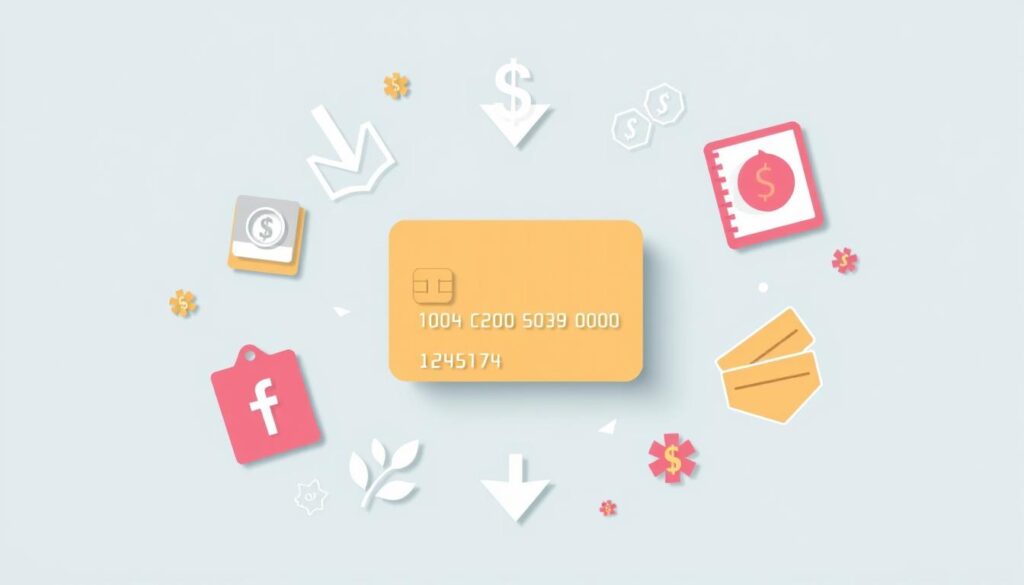I’m always looking for ways to save money, like managing credit card debt. High annual percentage rate (APR) rates are scary. But, you can lower your interest rate. It starts with knowing how to negotiate.
Negotiating can save you a lot of money. For example, if you owe $10,000 at 25% interest, you pay $2,500 in interest each year. By talking to your credit card company, you might get a better rate. A 10% rate could save you $1,000 a year.
Credit card companies want to keep your business, so they might listen to you. If you negotiate well, you could save a lot. With average rates around 16.88%, you have a good chance of getting a better deal. Saving $1,000 a year is worth a few minutes of your time.
In this article, I’ll share my own tips and success stories. It’s not just about saving money. It’s about taking control of your finances and feeling secure.
Understanding the Basics of Credit Card APR and Interest Rates
Managing credit card debt starts with knowing APR and interest rates. APR includes interest and any yearly charges. Knowing these basics can help you make better financial choices.
What is APR?
APR is the yearly cost of using your credit card. It’s a percentage that includes all fees and interest. A lower APR means you pay less to borrow money.
APRs vary from 9.99% for good credit to 25% for lower scores. This rate affects how much extra you’ll pay.
How Credit Card Interest Rates Work
Credit card companies set APRs based on your credit score. A high score can get you a lower rate. A lower score means a higher APR.
These rates can change with the prime rate. Knowing this can help you avoid extra charges.
The Impact of High APR on Your Finances
High APRs can make your debt much more expensive. If you only pay the minimum, you’ll pay a lot more than you borrowed.
This can lead to financial stress and longer debt times. Getting a lower APR can ease your financial load.
Understanding APR and interest rates helps you save money. Always check your APR and work on a good credit score. This can make your financial journey easier.
The Importance of a Good Credit Score in Lowering Your APR
My journey with credit scores has shown me their key role in financial health. A good credit score helps you get lower APRs from credit card companies. It shows you’re trustworthy and can get better loan terms.
Having a credit score above 670, as FICO suggests, makes you more attractive to lenders. It shows you manage credit well and are less likely to default. This makes lenders more willing to offer lower APRs.
- Statistically, credit scores affect borrowing costs: For example, a score between 760-850 on a $200,000 thirty-year mortgage might get you a 3.307% interest rate. This means monthly payments of about $877. But, a score between 620-639 could lead to a 4.869% rate and payments of $1,061. That’s a $184 monthly difference, or $66,343 over the loan’s life!
- Improving your credit score: Simple steps like paying bills on time and keeping credit use under 30% can boost your score. Remember, payment history and credit use make up 65% of your FICO score.
- Benefits beyond loans: A high credit score can also help in other ways. It can lower insurance costs and even affect job choices in some fields.
Knowing what affects your credit score and managing it can lead to lower APRs and more financial benefits. For instance, you might qualify for credit cards with 0% introductory APRs. This can help with big purchases or balance transfers without high interest rates.
In short, high credit scores make it easier to negotiate with credit card companies for lower APRs. They also open up many other financial benefits. So, it’s important to keep an eye on and improve your credit score. It has a big impact on your financial health and opportunities.
How to Lower Interest Rate on Credit Card
Do you want to cut down your credit card costs? Here’s how to use what you already have to get a lower interest rate. With rates between 16% and 24% this year, finding a better rate is worth trying.
Evaluating Your Current Credit Card Terms
First, understand your current situation. Check your statements for the APR and any special rates or perks. Credit card companies look at your payment history and how much you use your card. They want to see you use less than 30% of your limit.
Knowing your situation and how terms apply to you is important.
Gathering Competing Credit Card Offers
Look at what others are doing. If other cards have lower rates, you can use this to your advantage. Find offers that fit your financial needs and behavior. Showing your credit card issuer that you could go elsewhere might make them offer you a better deal.
Strategies for Negotiating with Credit Card Issuers
When you talk to your credit card company, be ready. Show them why you deserve a lower rate. Talk about how long you’ve been a customer, your on-time payments, and any other offers you’ve seen.
If the first person can’t help, ask for a supervisor. They might have more power to change your rate. Being persistent can sometimes get you what you want.
Even if you don’t get a lower rate right away, don’t give up. Rates and offers can change. Keeping in touch with your credit card company can help.
By understanding your credit card terms, finding good credit card offers, and knowing how to negotiate a lower rate with your credit card issuer, you can make your finances easier. A successful balance transfer can also help you manage your debts better.
Alternative Methods to Manage and Reduce Credit Card Interest
Looking for ways to cut down on credit card interest? There are more options than just asking for lower rates. You can use balance transfer cards, introductory APR offers, and smart debt repayment strategies. These tools help lower interest charges and speed up paying off debt.
Balance Transfer Credit Cards: Pros and Cons
Balance transfer cards are great for high-interest debt. They offer a 0% intro APR for 6-12 months. This lets you pay down debt without extra interest.
But, watch out for balance transfer fees, which can be 3% to 5% of the amount moved. Saving on interest is key, but pay off the balance before the intro period ends. If not, the regular APR kicks in.
Intro APR Offers and How They Work
Intro APR offers are great for managing debt, for new purchases or balance transfers. They give a low or zero percent APR for a set time after opening a card. It’s important to understand the terms and pay off the balance before the offer ends.
Not doing so can lead to high interest charges on what’s left. This can greatly increase your debt.
Utilizing Debt Repayment Strategies
Good debt repayment strategies are key to getting rid of credit card debt. Methods like the debt avalanche or snowball can help. They help you pay off debt faster by focusing on the right debts first.
The avalanche method targets high-interest debts first, saving you money. The snowball method starts with the smallest debts, giving you quick wins. Both can motivate you to keep paying.
Conclusion
I’ve shared tips on how to lower credit card interest rates and manage APRs. Knowing these tips can help you reduce credit card debt. With an average interest rate just below 21 percent, it’s key to look for ways to lower rates.
Keeping a good financial plan and credit score can lead to better offers. For example, the Wells Fargo Reflect® Card offers a 0 percent intro APR for 21 months. This can save you a lot of money.
Negotiating with your credit issuer can also help your finances. If you’re a good customer, they might give you a better deal. If not, balance transfer credit cards can be a good option. They might have a fee, but they can save you a lot of money.
Reducing credit card debt starts with finding ways to lower interest rates and APRs. Stay informed about special offers and know how to use your credit score. Being smart about payments can also help.
By using these strategies, you can get better terms or use balance transfer offers wisely. This not only reduces debt but also improves your financial health. It’s a journey that’s worth it, as each step brings you closer to being debt-free.







